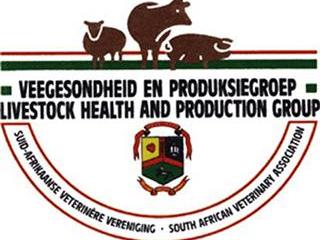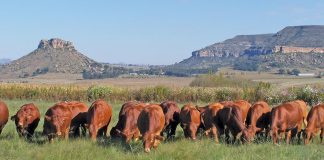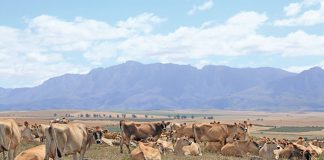
- Mpumalanga – Middelburg: roundworms.
- Gauteng – Bronkhorstspruit: roundworms. Onderstepoort: roundworm/verminosis – many herds affected with high egg counts and mortalities.
- North West – Brits and Christiana: roundworms.
- Free State – Harrismith: roundworms; ostertagia ostertagi. Heilbron: roundworms.
- KwaZulu-Natal – Underberg: Nematodirus – a large group of weaned Jersey calves showed ill thrift and diarrhoea that was initially thought to be due to lush kikuyu. Faecal flotation revealed Nematodirus spp. egg counts of over 300 eggs/gram. Camperdown, Mtubatuba, Pietermaritzburg and Vryheid: roundworms.
- Eastern Cape – Alexandria: roundworms. Graaff-Reinet: roundworms led to acute deaths in weaners – in some cases endoparasiticide resistance was established.
- Western Cape – Caledon: wireworms. George: roundworms.
- Northern Cape – Kimberley: heavy wireworm infestation in Dorper lambs.
It’s predicted that sheep and goat mortalities can be expected up to May if farmers don’t do faecal egg counts and regular observations (the five point check): nose and mouth; colour of the eye mucous membrane (Famacha system); bottle jaw, condition; and dag score (diarrhoea). By using this method problems caused by internal parasites will be identified. After each treatment the efficacy of the drug used should be evaluated as resistance to most of the actives have been reported.
* Tick numbers are also increasing in many parts of the country due to favourable conditions. The repeated usage of the long acting macrocyclic lactones against blue ticks will lead to selection for resistant ticks as has happened in South America.
Blue ticks are also carriers of the red water and anaplasma parasites, and with the increase in the tick populations many red water and anaplasmosis cases were reported and numerous deaths occurred due to Asiatic red water. Discuss management and vaccination programmes with your vet to combat these diseases. Test ticks for drug resistance.
Red water was reported in Balfour (three farms; two/three deaths/farm) , Ermelo, Lydenburg, Middelburg, Standerton (Mpumalanga); Bronkhorstspruit, Onderstepoort (Gauteng); Leeudoringstad (North West); Clocolan; Frankfort, Harrismith (Free State); Bergville (seen in calves a few days old and unvaccinated adults), Camperdown, Pietermaritzburg, Vryheid.
Anaplasmosis was reported in Onderstepoort (Gauteng); Christiana, Leeudoringstad, Stella, Ventersdorp, Vryheid (North West); Bethelem (in dairy cattle, with flies the main transmitters), Clocolan, Harrismith, Zastron (Free State); Bergville (main fly transmission); Pietermaritzburg, Underberg (unusual for this time of the year – traditionally the disease becomes a problem here in late summer or autumn), Vryheid (KZN); Alexandria (Eastern Cape); Darling, George (Western Cape).
* Heartwater occurred in areas where the disease has not been report before due to game carrying infected bont ticks into the farming areas:
- Gauteng – Onderstepoort: Many animals affected.
- Limpopo – Vaalwater: Bonsmara cattle introduced into the area were vaccinated on arrival and temperatures taken for three weeks, but reacted after that and three out of 14 died.
- North West – Brits: Fewer cases compared to earlier in the season. Leeudoringstad: Cattle infected probably due to buck coming across the Vaal River. Wolmaranstad: Stud Bonsmaras adjacent game farm died.
- Free State – Winburg: Infected sheep were brought in from the Eastern Cape.
- KZN – Camperdown, Mtubatuba, Pietermaritzburg, Pongola and Vryheid.
- Eastern Cape – Alexandria and Humansdorp.
* Bont-legged ticks are numerous and their toxin is resposible for the many sweating disease cases reported. These ticks have long mouth parts and their bites cause lameness in sheep and wounds which lead to screwworm attacks. Cases of Congo fever in humans were reported due to these ticks carrying the virus.
* Bleeding ears caused by numerous adult brown ear ticks were reported. It’s important to control the immature stages in winter to prevent this serious condition in summer.
* Summer environmental conditions favour the presence of flies which are carriers of numerous pathogens. One such bacteria is Moraxella, which is resposible for opthalmia. Contact your vet for a vaccination and treatment programme.
* Reports of increased numbers of midges, mosquitoes and biting flies came from certain areas. As these are vectors of some viral diseases, reports of lumpy skin disease, three day stiff sickness and blue tongue were also received.
* The venereal diseases trichomonosis and vibriosis are reported every month and cause huge economic losses. Talk to your vet about controlling these diseases and adhere strictly to a biosecurity programme.
* Red gut, blood gut and botulism were reported. All these dieases could have been prevented by following a vaccination programme.
* Calf diarrhoea is still a big problem in many beef herds. Causes include nutrition, rota and corona virus, E.coli, salmonellosis, coccidiosis and cryptosporidium.
* Snotsiekte still takes its toll every month and game farmers and cattle farmers should manage this disease as there is yet no vaccine against this viral disease.
* West Nile Fever was reported from Bronkhorstspruit. More research is needed as this disease is also a zoonosis.
* The following poisonings were reported: urea (licks got wet), fertilisers containing nitrogen, Lantana, Cestrum (inkbessie), gifblaar, prussic acid, acidosis, ergot, lead, photosensitization, termite bait, rye grass, organophosphate and sewejaartjie poisoning causing amaurosis (blindness).
Feedlot report
Sheep:
- Numerous deaths occurred due to pneumonia. The main contributing factors were transport, wet kraals and dust.
- Wireworm infestations have increased.
Cattle:
- Lumpy skin disease occurred north of Pretoria and in a feedlot in Cookhouse. Cases are regularly seen in feedlots, but the source of where cattle originated from is seldom established. It’s a fact that this disease is dormant in many areas of the country.
- Biting flies (Stomoxys) are a big problem and even under field conditions cattle are seen standing uncomfortable in groups.
- Anaplasmosis was seen in numerous feedlots and deaths occurred on numerous backgrounding farms.
- Parafilaria lesions were seen at abattoirs in cattle coming from the northern areas.
- Liver fluke lesions led to the condemning of numerous livers of C-grades as well as A-grades from the eastern part of the country and Limpopo.
Click on the link to view disease outbreaks in the your region and download the January disease report form.













